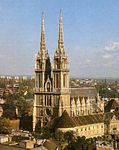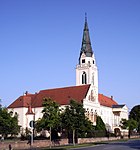Hermann Bollé

Hermann Bollé (born September 18, 1845 in Cologne , † July 17, 1926 in Zagreb ), of French - German origin, was one of the most important architects in Croatia .
Life
After completing the vocational school for construction, he worked in the studio of the Cologne architect Heinrich Wiethase , where he was involved in projects for churches and sacred buildings . From 1872 he studied architecture at the Vienna Art Academy and worked in parallel in the studio of the famous Austrian architect and cathedral builder Friedrich von Schmidt . In 1875 and 1876 he stayed in Italy , where he met Bishop Josef Georg Strossmayer and Isidor Kršnjavi. This meeting led his life to Croatia. As early as 1876 he came to Đakovo , where after the death of the architect K. Rösner he took over the construction of the Cathedral of St. Peter .
In the same year he carried out the restoration of the St. Mark's Church in Zagreb according to Schmidt's plans. Bollé finally settled in Zagreb in 1878. He was immediately entrusted with a wide variety of architectural, cultural and educational projects. After the earthquake of 1880 he was appointed chief restorer of the city's sacred and secular buildings.
In Croatia he restored and built numerous objects in the most varied of epochal styles, the Museum of Art and Crafts, the Vocational School and the Mirogoj Cemetery . In the spirit of romanticism, he renewed the cloisters of Marija Bistrica , the cathedral of Zagreb , the bishopric and the Curia of the Capitol in Zagreb. For this purpose he designed the Greek Catholic Cathedral of the Holy Trinity in Križevci (Croatia) in neo-Gothic style.
Under his influence, buildings emerged in Zagreb's urban life, and he also influenced all important questions of Zagreb cityscape design. The number of his works and projects in the applied arts is extensive, from furniture to theater costumes and productions to glass art, jewelry, crockery, lighting and the like. a.
Bollé's cultural and educational work is remarkable. He was an active member of the Kunstfreunde and one of the founders of the Museum of Art and Industry and the Vocational School, within the framework of which he also founded the School of Construction, which he directed for 32 years. With his students he also took part in major international exhibitions ( Trieste 1882, Budapest 1885 and 1886, Paris 1900), where he received several high prizes and awards. Despite the polemics that arose when looking at his work, Bollé undoubtedly played an important role in shaping the cityscape of Zagreb in the second half of the 19th century.
Also significant are the summer residences Bollés such as Višnjevac near Mali Radenci in Syrmia on the Syrmian loess plain not far from the Fruška Gora from 1905, as well as the Fišerov Salaš between Ruma and Jarak. While the summer residence Višnjevac was built as the so-called pudarska kuča (German: guardian of the vineyard) as the center of an agronomic business in the middle of the Syrmian loess plateau far away from urban settlements, the Fišerov salaš (salaš means farm) served as a representative summer residence primarily for the recreation of its owners in the countryside. In the middle of a park with rare exotic trees (including ginko), the wooden house surrounded by arcades was built with a thatched roof, which is unusual for the area. In Ruma itself, Bollé designed the Serbian Orthodox Church of the Holy Spirit and, in particular, the monumental iconostasis inside , the icons of which were made by Uroš Predić . In addition, two family graves were designed in the Ruma cemetery in Bollé.
photos
Individual evidence
- ↑ Stjepan Milcic: Hermann Bolle - the German builder of the Croatian capital Zagreb. In: ard-wien.de . May 16, 2015, accessed March 26, 2020.
- ^ Dragan Damjanovic: Viennese Academy of Fine Arts and Croatian Historicist Architecture. Croatian Students of Friedrich von Schmidt (Bečka Akademija likovnih umjetnosti i hrvatska arhitektura historicizma. Hrvatski učenici Friedricha von Schmidta); full text in English and German . ( academia.edu [accessed February 20, 2019]).
- ↑ Radio Televizija Vojvodine Letnjikovac Visnjevac
- ↑ Radio Televizija Vojvodine Fiserov Salas jedinstven u Vojvodini
- ↑ Serbian Academy of Sciences, Cultural Property of Serbia - Letnjikovac Fišerov salaš Летњиковац 'Фишеров салаш'
| personal data | |
|---|---|
| SURNAME | Bollé, Hermann |
| BRIEF DESCRIPTION | Croatian architect of French-German origin |
| DATE OF BIRTH | September 18, 1845 |
| PLACE OF BIRTH | Cologne |
| DATE OF DEATH | July 17, 1926 |
| Place of death | Zagreb |





